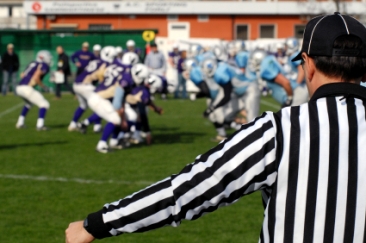Game officials are closest to the action and thus are often in the best position to detect the often subtle signs of concussions in athletes.
Unfortunately, sports officials don't usually have the power to order a sideline evaluation for concussion, if they reasonably suspect one has occurred, and often have received no formal concussion education. Parents' anxiety level watching their child play contact sports would likely to decrease if they knew that the adult closest to the action - the game official - was watching out for their child's safety.

Involving game officials in spotting concussions has caught on in Westchester County, New York. Members of the Westchester County Football Officials Association began carrying a card with a statement which, if they suspect a player has suffered a head injury, they are required to read to the player's coach recommending that he or she remove the player from the game for further assessment.
A promising move in the right direction: twelve of the new state concussion safety laws, including those enacted in Arizona, Iowa, and, most recently, Ohio, empower game officials to remove a player with a suspected concussion from the contest.* Several municipalities around the country have also enacted bylaws or ordinances doing the same, and the rules of the National Federation of State High School Associations (NFHS) for all high school sports, with minor variations, does the same.*
The number of concussions in football, and in other collision sports such as lacrosse, and hockey, could also be reduced, many believe, if game officials used a power they already possess: to call penalties for illegal helmet-to-helmet contact (as in football, hockey, and lacrosse), or overly-aggressive contact with another player going up for headers. A recent study of concussions in high school lacrosse, for example, blamed the high concussion rate in the sport on widespread and intentional use of helmets during player-to-player contact, often to defenseless players, and usually without a penalty being called. The systemic failure of referees to call penalties for illegal boarding, checking from behind, and intentional shots to the head in high school hockey has also been reported, prompting calls for stricter enforcement of rules in that sport.
Most recently, the leading researcher of sports injuries at the high school level called for better enforcement of existing rules against athlete-athlete contact by referees (e.g. by calling fouls and handing out yellow, or even red, cards) as one way of reducing the risk of concussion at all levels of the game.2
* Thanks to sports law expert Alan Goldberger of Summit, New Jersey for list of states in which game officials can remove players suspected of having sustained a concussion for a sideline evaluation and for the NFHS rule information.
Updated July 21, 2015
1. Lincoln AE, Caswell SV, Almquist JL, Dunn RE, Hinton RY. Video Incident Analysis of Concussions in Boys' High School Lacrosse. Am J Sport Med. 2013;20(10). doi:10.1177/0363546513476265 (published online ahead of print February 14, 2013)(accessed February 14, 2013).
2. Comstock RD, Currie DW, Pierpoint LA, Grubenhoff JA, Fields SK. An Evidence-Based Discussion of Heading The Ball And Concussions in High School Soccer. JAMA Pediatrics 2015; doi:10.1001/jamapediatrics.2015.1062 (publilshed online July 13, 2015)








